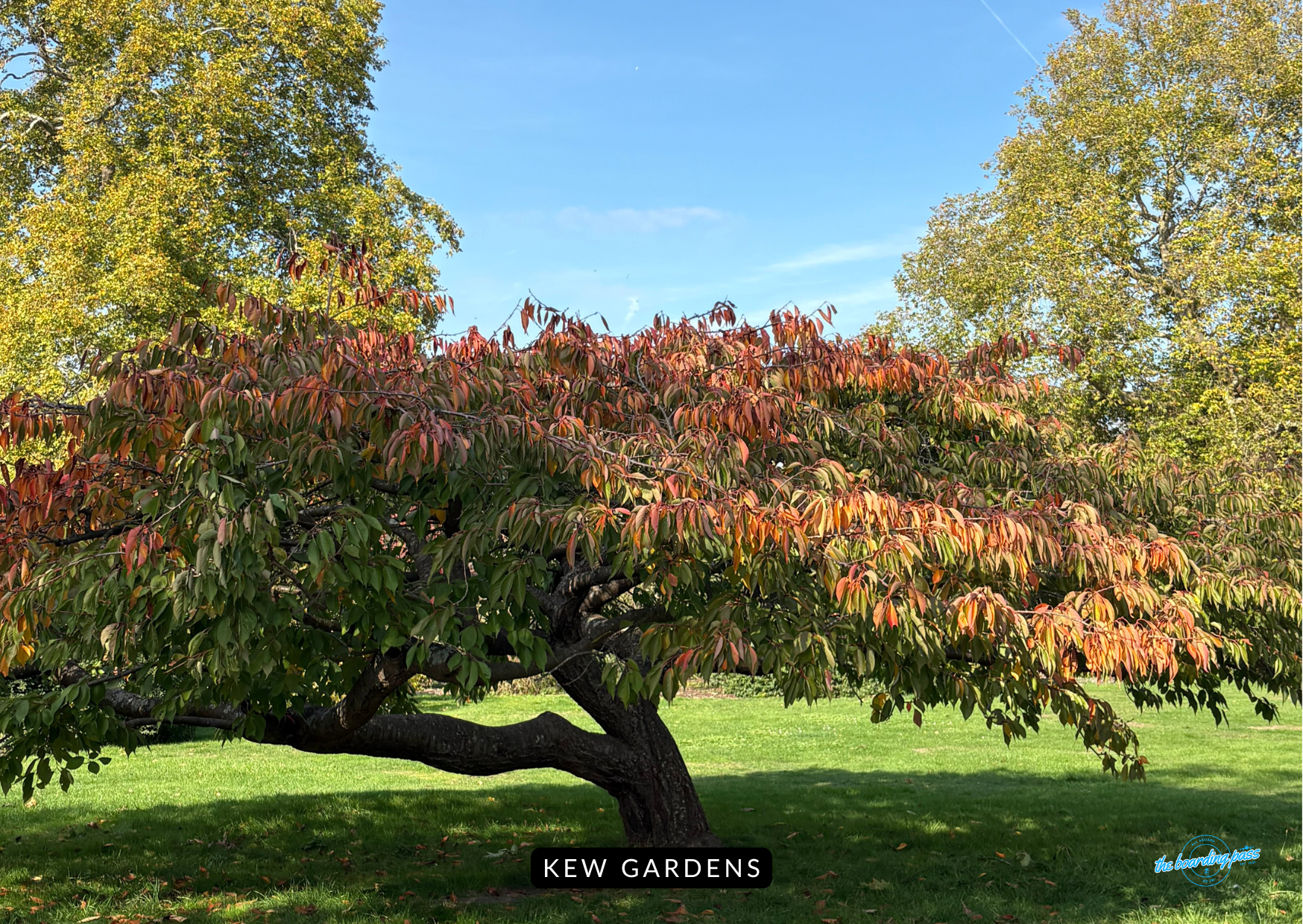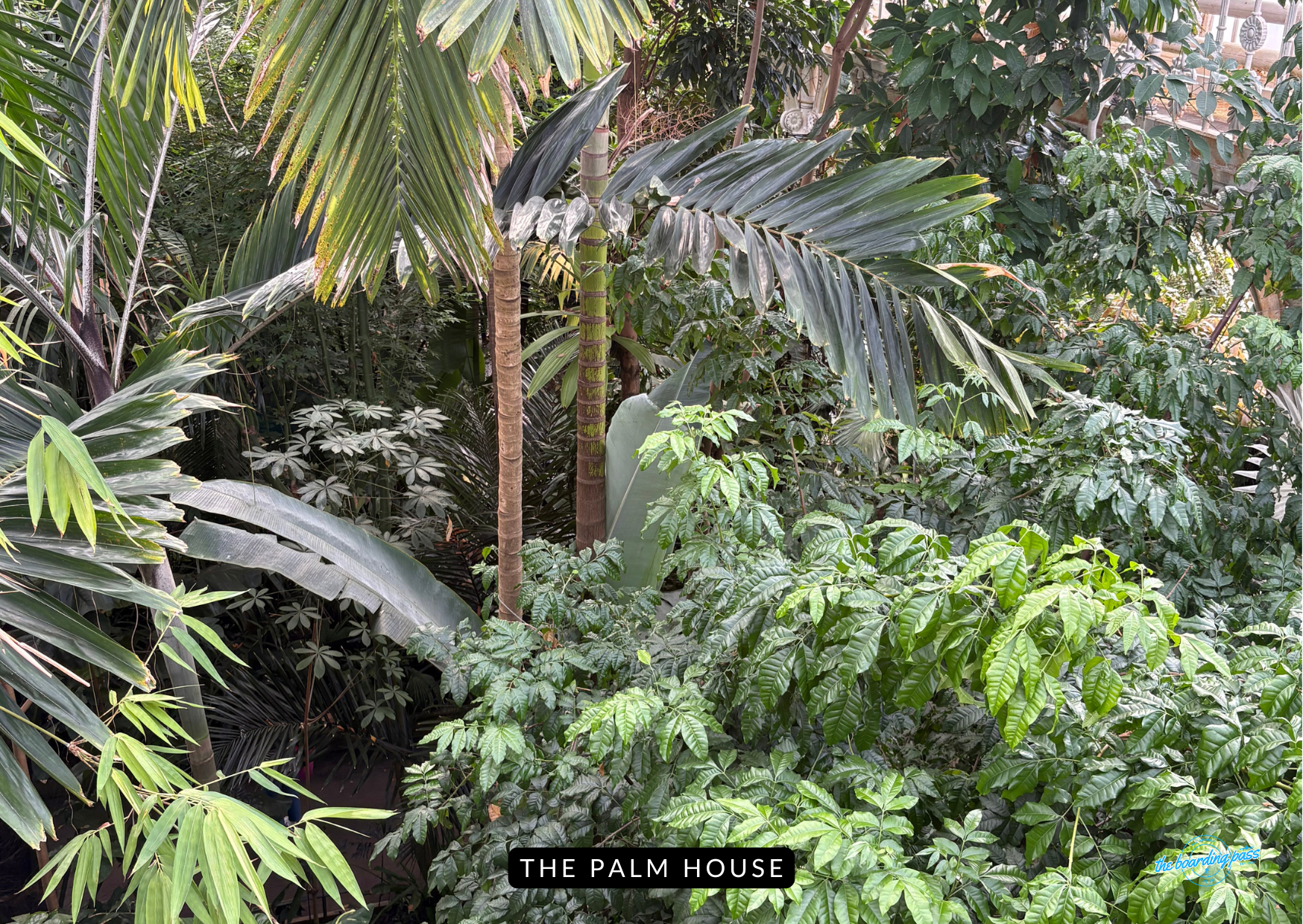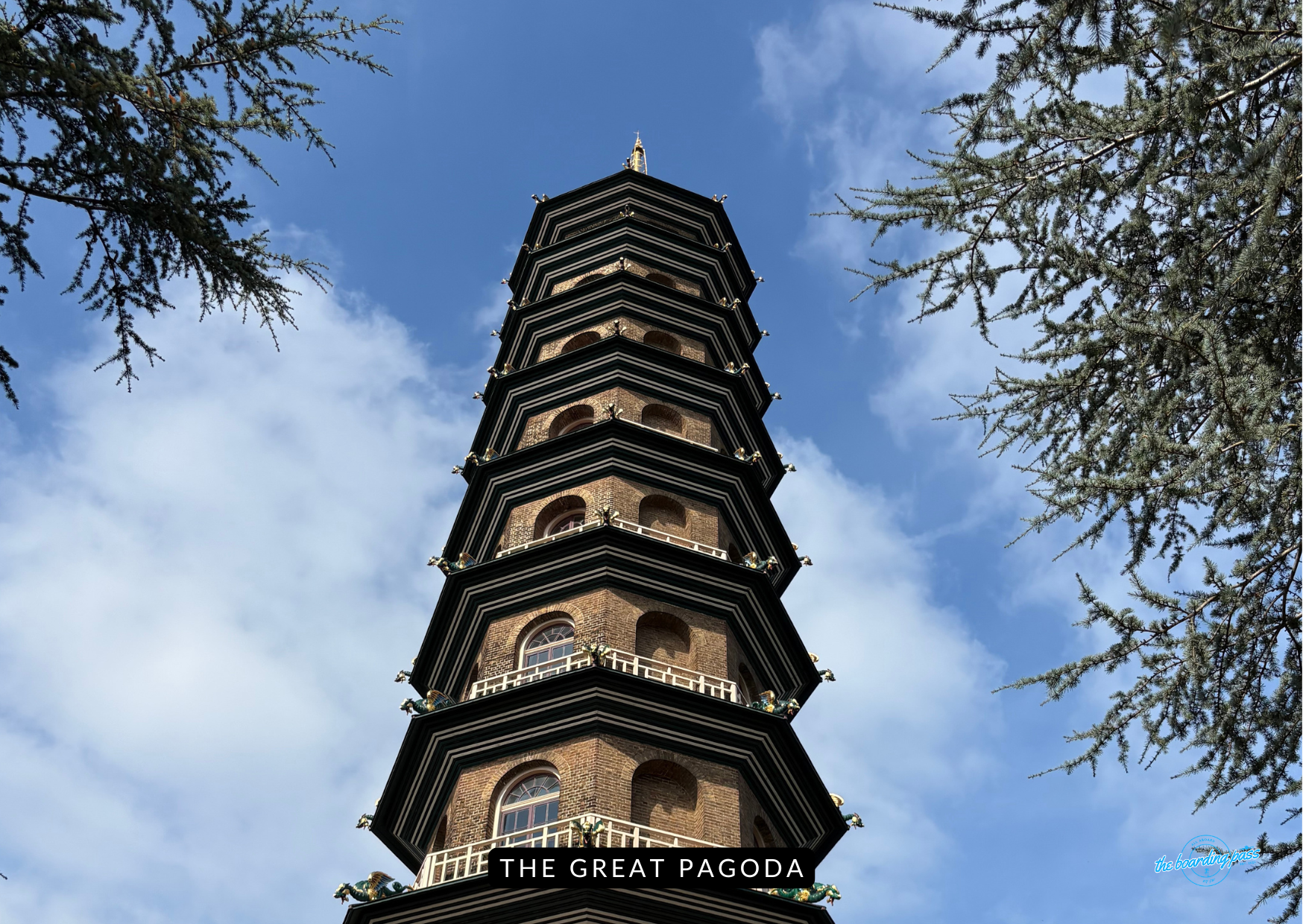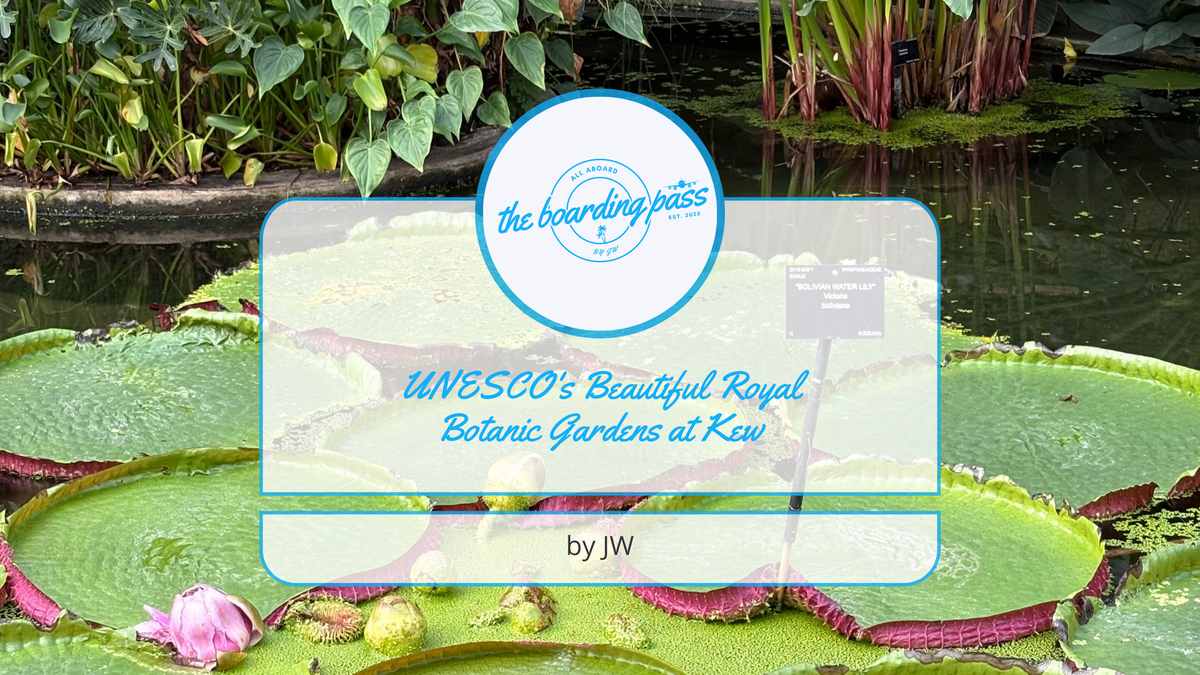Welcome back to The Boardingpass Travel Blog. Despite living just south of the River Thames, today marked my first visit to the Royal Botanic Gardens, Kew, and it didn’t disappoint. After a long and busy week, we needed to hit reset, conect with nature and do something fun. Kew felt like the perfect antidote. By the time we left at 4:30 p.m., our watch showed 15,000 steps, the sun still glowed across the glasshouses, and planes on final approach to Heathrow drifted quietly overhead. Apart from the fairly average café food, everything else about Kew was close to perfect, and we can’t wait to return.
Overview and Recognition

The Royal Botanic Gardens, Kew, commonly known as Kew Gardens, is one of the world’s most respected botanical institutions and scientific research centres. Situated in south-west London, this UNESCO World Heritage Site covers 326 acres of meticulously curated landscape beside the River Thames. It holds the largest and most diverse botanical and mycological collections on Earth, making it both a horticultural treasure and a hub of scientific innovation.
Kew holds a Guinness World Record for the largest collection of living plants at a single-site botanic garden, an astonishing 16,900 species as of 2019. That number keeps growing thanks to its ongoing conservation and global research partnerships. Research isn't cheap and it's easy to understand why tickets are priced at £24 for adults.
From lush glasshouses to quiet wooded corners, every part of Kew feels alive with purpose. It’s a rare blend of beauty and knowledge, a place where you can enjoy a picnic under 250-year-old trees while scientists nearby study DNA samples that could shape the planet’s environmental future.
A Short History of Royal Botanic Gardens, Kew
Kew’s story began in 1759, when Princess Augusta, mother of King George III, created a modest nine-acre botanic garden within the royal pleasure grounds. In 1772, the neighbouring estates of Richmond and Kew were merged under King George III, forming the foundation of today’s vast gardens.
Notable milestones include:
- 1761 – Construction of the Great Pagoda by William Chambers
- 1772 – Sir Joseph Banks, fresh from Captain Cook’s voyage, became Kew’s first unofficial director
- 1840 – The gardens were transferred to government control under Sir William Hooker and opened to the public
- 1848 – Completion of the Palm House
- 1863 – Opening of the Temperate House
- 2003 – Designated a UNESCO World Heritage Site
Over two and a half centuries, Kew has evolved from royal pleasure grounds to the world’s leading centre for botanical science, housing millions of specimens and attracting over two million visitors annually.
Collections and Scientific Resources
Living Collections at Kew Gardens
Across its 326 acres, Kew maintains over 50,000 living plant species, representing roughly 95 percent of all vascular plant genera known to science. These are arranged through themed gardens, tropical and temperate glasshouses, native woodland, and wildflower meadows.
The Herbarium
Kew’s Herbarium is legendary. It holds around seven million preserved specimens, including 330,000 type specimensthat serve as reference standards for plant identification. This living archive has been expanding for over 170 years, with 20,000 new additions each year, providing an unmatched record of global plant diversity.
The Millennium Seed Bank
A short journey south to Wakehurst, Sussex, brings you to Kew’s Millennium Seed Bank, an underground fortress safeguarding over 2.4 billion seeds from 40,000 species across more than 100 countries. It’s the world’s largest wild-plant seed storage project, ensuring endangered species survive even if lost in the wild.
Additional Collections
Kew’s supporting archives are just as impressive:
- Library: Over 750,000 volumes and 175,000 prints and drawings
- Fungarium: Global fungal diversity from every continent
- Economic Botany Collection: Tracing how humans use plants and fungi
- DNA and Tissue Bank: 58,000 samples representing nearly every flowering-plant family
Kew Gardens Architectural Highlights
Kew isn’t only about plants; it’s also a showcase of stunning Victorian engineering. The gardens feature 40 listed buildings, including four Grade I and 36 Grade II structures.
The Palm House

Built between 1844 and 1848, the Palm House is the world’s oldest surviving Victorian glasshouse. Designed by Decimus Burton and Richard Turner, its iron-and-glass structure was inspired by shipbuilding techniques of the time.
Inside, you’ll find towering tropical palms, dense humidity, and a glimpse into the kind of jungle explorers once dreamed of discovering.
The Temperate House
Twice the size of the Palm House, the Temperate House stretches 628 feet, making it the largest surviving Victorian glasshouse on Earth. Opened in 1863 and fully restored in 2018 after a £41 million project, it shelters 10,000 plantsfrom temperate zones worldwide.
The Great Pagoda

Built in 1762 as a royal gift from William Chambers to Princess Augusta, the ten-storey Pagoda remains one of Kew’s defining landmarks. Each level offers sweeping views over the gardens, and if you look closely, you’ll see the recently restored dragons perched on each roof tier. Sadly, The Great Pagoda wasn't open during our visit.
Science, Research and Global Reach
Behind Kew’s beauty is serious science. The organisation employs over 1,400 staff, including 530 scientists and 200 horticulturists, operating as a non-departmental public body sponsored by DEFRA.
Its global mission: to understand and protect plant life for the well-being of humanity and the planet.
Kew leads international collaborations through the Millennium Seed Bank Partnership, working with 150 organisations in 80 countries to safeguard the world’s plant species. Research spans taxonomy, conservation biology, molecular genetics, fungal science, and climate-change adaptation. The institution’s findings regularly inform government policy on biodiversity and sustainability.
Visiting Kew Gardens Opening Times and Admission
Kew is open daily 10 a.m.–6 p.m. (last entry 5 p.m.) in peak season.
Peak Season (Feb – Oct)
- Adults £22 (online) / £25 (gate)
- Children (4–15) £6 online / £8 gate
- Concessions £20 online / £23 gate
Off-Peak (Nov – Jan)
- Adults £14 online / £16 gate
- Children £5 online / £6 gate
- Concessions £12 online / £14 gate
The nearest station, Kew Gardens, is served by the District Line and London Overground, about a five-minute walk from the Victoria Gate entrance.
Annual Visitor Numbers to Kew Gardens
Kew welcomed over 2.3 million visitors in 2019, with its sister site Wakehurst drawing another 300,000. It remains one of London’s most-visited attractions, balancing tourism with its conservation mission.
Record-Breaking Plants
Kew’s dedication to botanical excellence has earned multiple Guinness World Records, including:
- Largest waterlily: Victoria amazonica with leaves up to 3 m wide
- Tallest / smelliest flower: Titan arum (Amorphophallus titanum) reaching 3 m in height
- Smallest waterlily: Nymphaea thermarum in the Princess of Wales Conservatory
- Longest pitcher plant trap: Nepenthes truncata
Conservation and Global Significance
Kew’s influence extends far beyond London. As a UNESCO World Heritage Site, it plays a crucial global role in:
- Conservation: Safeguarding endangered species and their genetic material
- Research: Expanding scientific understanding of plant diversity
- Education: Training future botanists and conservation leaders
- Policy: Advising governments on biodiversity and sustainability
Kew’s collections represent the most comprehensive botanical resource on the planet, and its work continues to address major challenges, from climate change and food security to habitat loss and ecosystem restoration.
Final Thoughts
A day at Kew feels like travelling the world without leaving London. You wander through tropical rainforests, alpine slopes, and African deserts all within a few acres. Add in the history, architecture, and sheer scale of the place, and it’s easy to see why Kew holds a special place in Britain’s cultural and scientific story.
We left with tired legs, full hearts, and a deep respect for this extraordinary garden. For anyone craving nature, learning, or a little quiet magic, Kew Gardens is unmissable.
Love The Boarding Pass Travel Blog?
Read Our Royal Greenwich Park Review
Kew Gardents FAQ
Q1: Why is Kew Gardens a UNESCO World Heritage Site?
A1: Kew Gardens earned UNESCO status in 2003 for its historic landscape, Victorian architecture, and role in global plant science and conservation.
Q2: How many plant species are in Kew Gardens?
A2: Kew holds more than 16,900 species of living plants, the largest collection of its kind in the world.
Q3: What’s the best time to visit Kew Gardens?
A3: Late spring through early autumn offers the fullest blooms and open glasshouses, but winter walks and light trails are equally beautiful.
Q4: How long does it take to explore Kew Gardens?
A4: Most visitors spend four to five hours exploring Kew’s highlights, including the Palm House, Temperate House, and the Great Pagoda.

